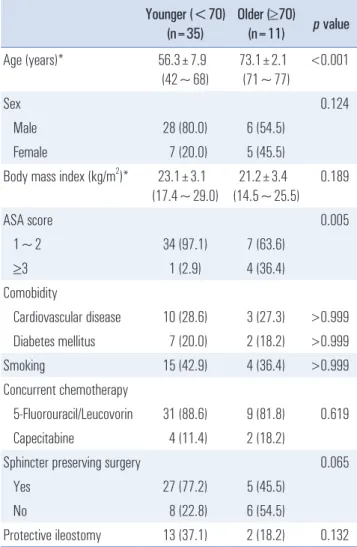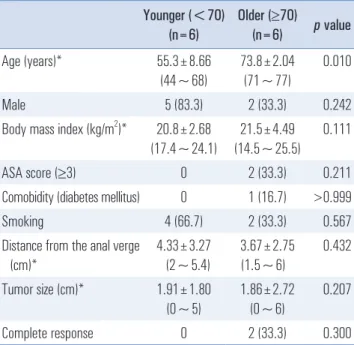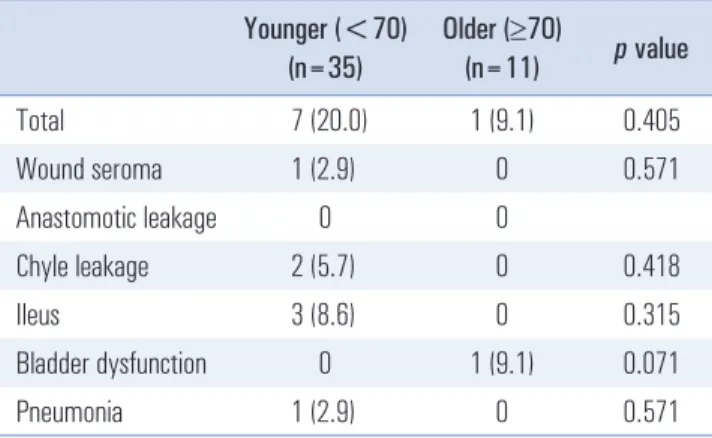Laparoscopic Surgery for Rectal Cancer after Preoperative Chemoradiation in Elderly Patients
Je-Min Choi, M.D., Seung-Hun Lee, M.D., Seung-Hyun Lee, M.D., Byung-Kwon Ahn, M.D.
Department of Surgery, Kosin University College of Medicine, Busan, Korea
Purpose:
Laparoscopic surgery has been accepted as a standard procedure for colorectal cancer.Preoperative chemoradiation for rectal cancer has some advantages, such as decreased tumor size and lower stage, and lower local recurrence. However, preoperative chemoradiation has the disadvantage of increasing postoperative complication risks. The aim of this study was to evaluate the safety of laparoscopic surgery for rectal cancer after preoperative chemoradiation in elderly patients.
Methods:
46 patients underwent laparoscopic surgery for rectal cancer after preoperative chemoradiation. Patients were divided into younger (<70 years, n=35) and older groups (≥70 years, n=11).Results:
In the younger group, men were more predominant (80% vs. 54.5%, p=0.124). In the older group, more patients had high American Society of Anesthesiologists scores (score 3 was 2.9% vs.36.4%, p=0.005) than in the younger group. Sphincter-preserving surgery was performed more frequently in the younger group (77.2% vs. 45.5%, p=0.065). Operation time (195.8 min. vs. 212.5 min, p=0.553) and intraoperative blood loss (200.6 cc vs. 209.1 cc, p=0.952) were not significantly different.
Significant anastomotic leakage was absent in both groups. Postoperative hospital stay was 9.7 and 10.9 days (p=0.669). Complete remission rates were similar in the both groups (8.8% vs. 18.2%, p=0.824).
Conclusion:
Postoperative outcomes are comparable between older group and younger group.Laparoscopic surgery could be considered as safe, feasible therapeutic options in elderly patients after preoperative chemoradiation for rectal cancer. However, large randomized trials with comparative methodologies are needed.
Keywords:
Laparoscopic surgery, Rectal cancer, RadiationReceived June 27, 2017 Revised 1st August 22, 2017
2nd August 26, 2017 3rd August 30, 2017 Accepted August 31, 2017
Corresponding author Seung-Hun Lee
Department of Surgery, Kosin University College of Medicine, 262 Gamcheon-ro, Seo-gu, Busan 49267, Korea
Tel: +82-51-990-6462 Fax: +82-51-246-6093 E-mail: candoli8182@naver.com
This is an Open Access article distributed under the terms of the Creative Commons Attribution Non-Commercial License (http://
creativecommons.org/licenses/by-nc/4.0/) which permits unrestricted non-commercial use, distribution, and reproduction in any medium, provided the original work is properly cited.
Copyright © 2017 The Journal of Minimally Invasive Surgery. All rights reserved.
Journal of Minimally Invasive Surgery
J Minim Invasive Surg 2017;20(3):108-112
InTRODUCTIOn
Preoperative chemoradiation for rectal cancer has some advantages such as decreased tumor size and lower stage and lower local recurrence. The disadvantage of increased post- operative complication risks is debated.
1,2Elderly patients have a high incidence of colorectal cancer, which may be associ- ated with increased postoperative morbidity and mortality due
to complex comorbidities and diminished cardiopulmonary reserves. Preoperative chemoradiation and old age are con- sidered as risk factors of postoperative complication of rectal cancer patients.
Laparoscopic surgery for colorectal cancer has been ac- cepted as a standard procedure and has become popular.
Several studies suggest that laparoscopic surgery for colorectal
cancers has benefits over open surgery, including less wound
pain, earlier recovery, and better cosmetic results, all with similar postoperative outcomes and long-term oncologic re- sults.
3-5Several studies show similar overall postoperative complication rates between open surgery and laparoscopic surgery for rectal cancer after preoperative chemoradiation.
6,7With advancement of laparoscopic techniques, several studies show that laparoscopic colorectal surgery is a safe and feasible procedure, even in elderly patients.
8,9However, the safety of laparoscopic surgery in elderly pa- tients after preoperative chemoradiation is unknown. The aim of this study was to evaluate the safety of laparoscopic surgery for rectal cancer after preoperative chemoradiation in elderly patients.
MATERIALS AnD METHODS
The study protocol was approved by the institutional review board. From a prospectively collected database of all patients undergoing colorectal surgery in our department, 46 con- secutive patients were selected who underwent laparoscopic surgery after preoperative chemoradiation for rectal cancer from January 2009 to June 2014. All patients were diagnosed with adenocarcinoma in the rectum with tumors <15 cm from the anal verge. Preoperative assessment included digital rec- tal examination, colonoscopy with biopsy, rectal ultrasound, abdominopelvic computed tomography (CT), chest x-ray, and laboratory data including complete blood cell count, biochem- ical profiles, serum carcinoembryonic antigen (CEA), and cancer antigen (CA 19-9).
Patients with CTs showing locally advanced tumor (i.e., penetrating through the rectal wall, T3), and/or tumor with lymph node involvement without evidence of distant metasta- sis were given the option of preoperative chemoradiation ther- apy. As preoperative chemoradiation therapy, radiation therapy and chemotherapy were administered simultaneously. Radia- tion was irradiation using a 10-MV linear accelerator from three directions, posterior, right, and left sides, using a wedge.
Upper radiation range was up to the fifth lumbar vertebra (L5) or the first sacral vertebra (S1), and laterally, up to the pelvic wall. External iliac lymph nodes were not included in radia- tion, and special preparation to protect the small intestine was not performed. For radiation doses, 200 cGy per fraction was used once a day, 5 times per week, for total radiation dose 5,000~5,400 cGy. For combined chemotherapy, a combination of 450 mg/m
25-fluorouracil and 20 mg/m
2leucovorine was infused continuously for 24 hours with initiation of radia- tion therapy, concomitantly or 1,250 mg/m
2oral capecitabine (Xeloda
®, Hoffmann-La Roche Ltd., Basel, Switzerland) was administered per day. Surgery was performed an average 8~10 weeks after chemoradiation therapy. All patients underwent
mechanical bowel preparation. The laparoscopic surgery pro- gram at our department began in 2004.
Patients were divided into a younger group aged younger than 70 years and an older group aged 70 and older. Medi- cal records were retrospectively reviewed for demographics, comorbidity, operation methods, operative time, intraoperative blood loss, postoperative hospital stay, postoperative compli- cations, and pathology results. Operation time was defined as time from initial incision until end of the operation with dressing in place. Operative complications and mortality were defined as complications and death within 30 days of surgery.
SPSS version 17.0 for Windows software (SPSS Inc., Chi- cago, IL, USA) was used for statistical analysis. Mann Whit- ney test was used to compare normally distributed variables.
Comparisons between groups of discrete variables were made using chi-squared or Fisher’s exact tests as appropriate. All p values <0.05 were considered statistically significant.
Table 1. Demographics of patients
Younger (<70) (n=35)
Older (≥70)
(n=11) p value
Age (years)* 56.3±7.9
(42~68)
73.1±2.1 (71~77)
<0.001
Sex 0.124
Male 28 (80.0) 6 (54.5)
Female 7 (20.0) 5 (45.5)
Body mass index (kg/m
2)* 23.1±3.1 (17.4~29.0)
21.2±3.4 (14.5~25.5)
0.189
ASA score 0.005
1~2 34 (97.1) 7 (63.6)
≥3 1 (2.9) 4 (36.4)
Comobidity
Cardiovascular disease 10 (28.6) 3 (27.3) >0.999 Diabetes mellitus 7 (20.0) 2 (18.2) >0.999
Smoking 15 (42.9) 4 (36.4) >0.999
Concurrent chemotherapy
5-Fluorouracil/Leucovorin 31 (88.6) 9 (81.8) 0.619 Capecitabine 4 (11.4) 2 (18.2)
Sphincter preserving surgery 0.065
Yes 27 (77.2) 5 (45.5)
No 8 (22.8) 6 (54.5)
Protective ileostomy 13 (37.1) 2 (18.2) 0.132
*Values are mean (range); other values in parentheses are percentage.
RESULTS
Of 46 total patients, 35 were in the younger group less than 70 years; 11 were in the older group aged more than 70 years.
Demographics and preoperative variables are in Tables 1 and 2. In the younger group, men were more prominent (80% vs.
54.5%, p=0.124). In the older group, more patients had high American Society of Anesthesiologists (ASA) scores (≥3 score, 2.9% vs. 36.4%, p=0.005). Mean values for BMI (23.1 vs. 21.2), distance from anal verge (5.53 cm vs. 5.45 cm), and tumor size (2.69 cm vs. 2.46 cm) were similar for the two groups. Sphinc- ter-preserving surgery, such as lower anterior or intersphinc- teric resection was performed more frequently in the younger group (77.2% vs. 45.5%, p=0.065). Abdominoperineal resec- tion was done in 6 patients in each group (17.1% vs. 54.5%). In the younger group with no sphincter preserving surgery, two patients underwent Hartmann ’s procedure or colostomy. Pro- tective ileostomy was performed on 13 patients (37.1%) in the younger, and 2 patients (18.2%) in the older group. Complete remission rate was higher in the older group, but not signifi- cantly different (8.8% vs. 18.2%, p=0.824). In the older group, two patients (18.2%) showed pathologically complete response;
the two patients underwent abdominoperineal resection (Table 3). Mean distance from the anal verge was 7.6 cm in patients who underwent sphincter-preserving surgery and 3.6 cm in patients who underwent abdominoperineal resection in both group. Mean tumor size was 3.2 cm and 1.8 cm.
Operative outcomes and postoperative complications are in Tables 4, 5. Operation time (195.8 min vs. 212.5 min p=0.553) and intraoperative blood loss (200.6 cc vs. 209.1 cc, p=0.952) were not significantly different. Anastomotic leakage was absent in both groups. Postoperative hospital stay was 9.7 and 10.9 days ( p=0.669).
DISCUSSIOn
The incidence of colorectal cancer in older patients is likely to increase with an aging population. With average life expec- tancy becomes longer, colorectal surgery in older patients oc- curs more frequently. However, older patients may have com- plex comorbidities and diminished cardiopulmonary reserves, which are associated with increased morbidity and mortality from colorectal surgery.
10,11Laparoscopic colorectal surgery has become more prevalent worldwide. Several studies have suggested that laparoscopic surgery for colorectal cancer may have some benefits such as less wound pain, earlier recovery, and better cosmetic results, with similar postoperative outcomes to open surgery.
3-5How- ever, laparoscopic surgery requires pneumoperitoneum with carbon dioxide gas, which may reduce venous return, diminish cardiac output and cause hypercarbia. This procedure should be used selectively in older patients with limited cardiopulmo- nary reserves. Several studies report that, with advancement of anesthetic and surgical techniques, laparoscopic colorectal
Table 2. Clinicopathologic characteristics of rectal cancers Younger (<70)
(n=35)
Older (≥70)
(n=11) p value Distance from the anal verge
(cm)*
5.53±2.66 (2~10)
5.45±3.62 (1.5~12)
0.605 Tumor size (cm)* 2.69±2.04
(0~7.0)
2.46±2.32 (0~6)
0.776
Differentiation 0.777
Well-moderate 30 (85.7) 10 (90.9)
Poor 2 (5.7) 0
Mucinous 3 (8.6) 1 (9.1)
Pathologic stage 0.824
0
†3 (8.8) 2 (18.2)
1 10 (29.4) 3 (27.3)
2 9 (26.5) 2 (18.2)
3 12 (35.3) 4 (36.4)
*Values are mean (range); other values in parentheses are percentage,
†
complete response.
Table 3. Demographics of patients underwent APR Younger (<70)
(n=6)
Older (≥70)
(n=6) p value
Age (years)* 55.3±8.66
(44~68)
73.8±2.04 (71~77)
0.010
Male 5 (83.3) 2 (33.3) 0.242
Body mass index (kg/m
2)* 20.8±2.68 (17.4~24.1)
21.5±4.49 (14.5~25.5)
0.111
ASA score (≥3) 0 2 (33.3) 0.211
Comobidity (diabetes mellitus) 0 1 (16.7) >0.999
Smoking 4 (66.7) 2 (33.3) 0.567
Distance from the anal verge (cm)*
4.33±3.27 (2~5.4)
3.67±2.75 (1.5~6)
0.432 Tumor size (cm)* 1.91±1.80
(0~5)
1.86±2.72 (0~6)
0.207
Complete response 0 2 (33.3) 0.300
*Values are mean (range); other values in parentheses are percentage,
APR = abdominoperineal resection.
surgery in older patients is a safe and feasible procedure.
8,9Bottino et al.
8compared postoperative outcomes in two groups divided according to the age of 75 years. Conversion rate to open surgery was the same between the two groups. Postoper- ative complication rates were also the same but with increased in cardiopulmonary complications in older patients. No mor- tality occurred. Jeong et al.
9compared short-term outcomes in patients who were ≥75 years (n=92) and 75 (n=824). They reported that higher overall complication rate in patients ≥75 years (12.0% vs. 6.2%, p=0.047). However, clinically significant complications were not different between the two groups. This result suggests that laparoscopic colorectal surgery in older patients is safe and feasible. Fiscon et al.
12compared postop- erative outcomes between matched two groups of people ≥75 years (n=50) and 75 (n=50). The study showed more postop- erative complications in older patients, even when matched by ASA score and type of operation. They suggested that in older patients, laparoscopic colorectal surgery should be performed by experienced surgeons in specialized centers.
Compared to younger groups, the incidence of postoperative complications increases in older groups undergoing laparo- scopic colorectal surgery. In an aging population, comparing between open surgery and laparoscopic surgery, laparoscopic colorectal surgery has advantages in postoperative complica- tions, time to return of normal bowel function, and duration of hospital stay
13,14Vallribera et al.
14compared morbidity and mortality between open and laparoscopic surgery groups in older people ≥75 years. They reported a lower overall com- plication rate (37.3 vs. 21.6%, p=0.001) with fewer surgical site infections in the laparoscopic surgery group. Mortality was also lower (6.7% vs. 3.2%, p=0.034) and duration of hospital stay was shorter (11.4 days vs. 7.8 days).
Rectal surgery is more challenging for surgeons than colon surgery. Surgeons have to consider the narrow pelvic cavity, nerve preservation, sphincter saving and radiation effects in rectal surgery. Preoperative chemoradiation for rectal cancer
is a known significant risk factor for anastomotic leakage in open and laparoscopic surgery.
15,16Park et al.
16assessed the risk factors for clinical anastomotic leakage in patients undergo- ing laparoscopic surgery for rectal cancer. In patients without defunctioning stoma, anastomotic leakage percentages were 6.1% vs. 16.2% according to use of preoperative chemoradia- tion ( p=0.001) in univariable and multivariable analysis. In the study, anastomotic leakage was not significantly different (5.4%
vs. 7.3%, p=0.326) for age ≥75 or <75 years.
Our study focused on older patients (≥70 years) who under- went laparoscopic surgery for rectal cancer after preoperative chemoradiation.
17-19In the older group, patients with high ASA scores (≥3 score, 2.9% vs. 36.4%, p=0.005) were prominent.
Sphincter-preserving surgery such as lower anterior resec- tion and intersphincteric resection was done in the younger group more frequently than the older group (77.2% vs. 45.5%, p=0.065). Also, protective ileostomy was more frequent in the younger group. We may consider abdominoperineal resection more frequently in an older group with poor anal sphincter tone. In two patients with complete response to preoperative chemoradiation, both underwent abdominoperineal resection (Table 3). For anastomotic leakage, mortality did not occur in the both groups. However, this study has some limitations, such as small numbers of patient, retrospective, not matched, not randomized.
In conclusion, even in elderly patients after preoperative chemoradiation for rectal cancer, postoperative outcomes of laparoscopic surgery and open surgery was not different sig- nificantly. Laparoscopic surgery could be considered as a safe, feasible therapeutic option in elderly patients after chemora- diation. However, large randomized trials with comparative methodology are needed.
REfEREnCES
1) Marijnen CA, Kapiteijn E, van de Velde CJ, et al. Acute side
Table 4. Operative outcomes
Younger (<70) (n=35)
Older (≥70)
(n=11) p value Operative time (min)* 195.9±66.41
(140.0~380.0)
215.5±84.01 (120.0~320.0)
0.553 Blood loss (cc) 200.6±188.26
(50~1,000)
209.1±205.93 (50~800)
0.952 Postoperative hospital
stay (days)
9.7±4.11 (4~26)
10.9±5.38 (6~26)
0.669 Sampled lymph node 11.3±6.76
(0~30)
13.7±6.63 (0~25)
0.496
Table 5. Postoperative complications Younger (<70)
(n=35)
Older (≥70)
(n=11) p value
Total 7 (20.0) 1 (9.1) 0.405
Wound seroma 1 (2.9) 0 0.571
Anastomotic leakage 0 0
Chyle leakage 2 (5.7) 0 0.418
Ileus 3 (8.6) 0 0.315
Bladder dysfunction 0 1 (9.1) 0.071
Pneumonia 1 (2.9) 0 0.571
effects and complications after short-term preoperative radio- therapy combined with total mesorectal excision in primary rectal cancer: report of a multicenter randomized trial. J Clin Oncol 2002;20:817-825.
2) Holm T, Singnomklao T, Rutqvist LE, Cedermark B. Adjuvant preoperative radiotherapy in patients with rectal carcinoma. Ad- verse effects during long term follow-up of two randomized trials.
Cancer 1996;78:968-976.
3) Clinical Outcomes of Surgical Therapy Study Group, Nelson H, Sargent DJ, et al. A comparison of laparoscopically assisted and open colectomy for colon cancer. N Engl J Med 2004;350:2050- 2059.
4) Veldkamp R, Kuhry E, Hop WC, et al. Laparoscopic surgery versus open surgery for colon cancer: short-term outcomes of a randomised trial. Lancet Oncol 2005;6:477-484.
5) Guillou PJ, Quirke P, Thorpe H, et al. Short-term endpoints of conventional versus laparoscopic-assisted surgery in patients with colorectal cancer (MRC CLASICC trial): multicentre, randomised controlled trial. Lancet 2005;365:1718-1726.
6) Kang SB, Park JW, Jeong SY, et al. Open versus laparoscopic sur- gery for mid or low rectal cancer after neoadjuvant chemoradio- therapy (COREAN trial): short-term outcomes of an open-label randomised controlled trial. Lancet Oncol 2010;11:637-645.
7) Ishihara S, Watanabe T, Fukushima Y, et al. Safety and factors contributing to the difficulty of laparoscopic surgery for rectal cancer treated with preoperative chemoradiotherapy. Tech Colo- proctol 2014;18:247-255.
8) Bottino V, Esposito MG, Mottola A, et al. Early outcomes of colon laparoscopic resection in the elderly patients compared with the younger. BMC Surg 2012;12 Suppl 1:S8.
9) Jeong DH, Hur H, Min BS, Baik SH, Kim NK. Safety and feasi- bility of a laparoscopic colorectal cancer resection in elderly pa- tients. Ann Coloproctol 2013;29:22-27.
10) Al-Refaie WB, Parsons HM, Habermann EB, et al. Operative outcomes beyond 30-day mortality: colorectal cancer surgery in oldest old. Ann Surg 2011;253:947-952.
11) Tan KK, Koh FH, Tan YY, Liu JZ, Sim R. Long-term outcome following surgery for colorectal cancers in octogenarians: a single institution’s experience of 204 patients. J Gastrointest Surg 2012;16:1029-1036.
12) Fiscon V, Portale G, Frigo F, Migliorini G. Laparoscopic resection of colorectal cancer: matched comparison in elderly and younger patients. Tech Coloproctol 2010;14:323-327.
13) Grailey K, Markar SR, Karthikesalingam A, Aboud R, Ziprin P, Faiz O. Laparoscopic versus open colorectal resection in the el- derly population. Surg Endosc 2013;27:19-30.
14) Vallribera Valls F, Landi F, Espin Basany E, et al. Laparoscopy- assisted versus open colectomy for treatment of colon cancer in the elderly: morbidity and mortality outcomes in 545 patients.
Surg Endosc 2014;28:3373-3378.
15) Lee WS, Yun SH, Roh YN, et al. Risk factors and clinical outcome for anastomotic leakage after total mesorectal excision for rectal cancer. World J Surg 2008;32:1124-1129.
16) Park JS, Choi GS, Kim SH, et al. Multicenter analysis of risk fac- tors for anastomotic leakage after laparoscopic rectal cancer exci- sion: the Korean laparoscopic colorectal surgery study group. Ann Surg 2013;257:665-671.
17) Law WL, Chu KW, Tung PH. Laparoscopic colorectal resection: a safe option for elderly patients. J Am Coll Surg 2002;195:768-773.
18) Frasson M, Braga M, Vignali A, Zuliani W, Di Carlo V. Benefits of laparoscopic colorectal resection are more pronounced in elderly patients. Dis Colon Rectum 2008;51:296-300.
19) Gultekin FA, Wong MT, Podevin J, et al. Safety of laparoscopic ventral rectopexy in the elderly: results from a nationwide data- base. Dis Colon Rectum 2015;58:339-343.


